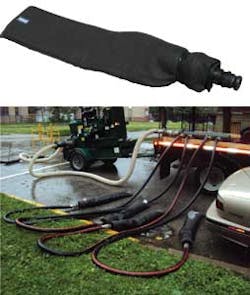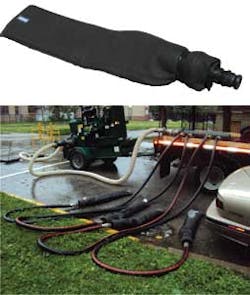Product Focus: Filtration System
Abranch of environmental contractor PSC in Elk Gove Village, Ill., was hired by a local electrical utility to dewater vaults and manholes in Chicago and its suburbs. Such water discharge operations require periodic draining, both to ensure equipment installers of safe working conditions and to protect the environment.
The need to cost-effectively dewater the manholes led PSC to a unique design using multiple C.I.Agent® EVAC Filtration Systems. The EVAC system comprises a four-layer design that adsorbs hydrocarbons, removes large and fine sediment and contaminants, and polishes the water in a variety of applications, such as elevator shafts, underground utility vaults and manholes, retention and secondary containment vessels, and outfall on oil-water separators.
Rather than resort to vacuum trucks and the expensive related water processing fees, PSC devised a highly-efficient pump and filtration configuration. A 2,500+ GPM centrifugal pump connects to a multi-port manifold, to which up to seven EVAC Filtration Systems attach. Quickly removing and processing large volumes of contaminated water enabled PSC to complete jobs efficiently and cost-effectively. After implementation, PSC realized significant savings with the manifold invention. From initial setup to teardown, even the power utility's largest manholes and vaults were cleared of contaminated water within 30 minutes.
PSC now uses the multiple-filter technique with many of its customers, said Jim Chaggaris, president of PowerOne, a sales company in St. Charles, Ill., serving utilities, industrial and commercial markets in a four-state area. "They've taken C.I.Agent Solutions' technology and adapted it to better serve the needs of their customers," said Chaggaris. "This custom method reduces their dewatering times by up to 75 percent and gives them a competitive edge."
Each filter's non-woven geotextile is an environmentally-friendly and proprietary blend of seven polymers that encapsulates and solidifies harmful hydrocarbons. The geotextile is lipophilic (adsorbs 10 times its weight in hydrocarbons), is hydrophobic and exceeds MARV 97.7%. Further, the filters are transformed into a non-toxic, non-leaching, rubber-like mass ready for safe disposal. Since each manifold port can be shut off independently, a saturated EVAC filter can be changed while others continue filtering.
Every C.I.Agent EVAC Filtration System comes with a 2" male Camlock quick-connect fitting and is packaged in a 6.5-gallon, UN-certified liquid-tight container with a sure-seal screw top lid. The reusable filtration bag's outer skin contains a hydrocarbon detection strip, so users can tell when filtering nears maximum hydrocarbon retention levels. The filtration system can also efficiently capture contaminants when dewatering elevator shafts or retention and secondary containment vessels, or for processing oil-water separator outfall.

